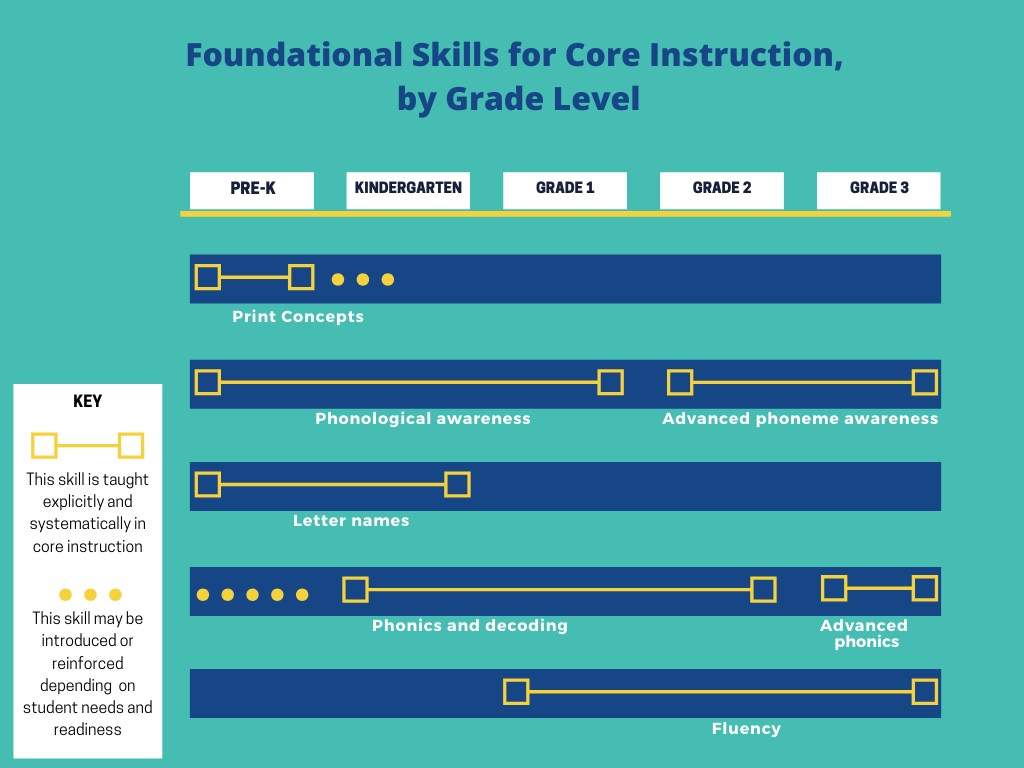Foundational Literacy Skills Instruction for All
In Pre-Kindergarten through third grade, children develop phonological awareness (including more advanced phonemic awareness), print concepts, phonics knowledge (including advanced phonics), and decoding skills, all of which contribute to the development of fluent reading. These skills are a necessary foundation to reach the ultimate goal of reading: comprehension. All children should participate in daily core instruction in foundational skills, as one part of a complete literacy program, alongside the development of oral language and in connection with engaging with authentic text and writing. In the early grades, children need engaging, active, repetitive, and efficient practice within a culturally responsive context to develop these foundational skills of literacy.
Explicit and systematic core instruction ensures that all children have equitable opportunity to learn and practice foundational skills. Differentiated foundational skills instruction in small groups is also necessary because students develop uniquely and need varying amounts of time on different skills. Assessment informs instruction that meets the unique needs of each child.
The chart below provides an overview of that instruction, and, although the foundational skills are discussed individually, they are interrelated in their development.

Culturally Responsive Practice in Foundational Skills Instruction
Learning to read words seems to come effortlessly to some children, but for many it is hard work. Effective practice involves trying out the new skill, making some mistakes, and receiving corrective feedback from the teacher. A trusting and respectful relationship between student and teacher and a basic understanding of the linguistic assets a student brings are a necessary context for practice with corrective feedback. In a space that is safe and supportive, students are better able to persevere in practicing these skills until they are secured.
While corrective feedback to multilingual students is necessary, it should always be provided in an affirming way and in a way that helps students build metalinguistic awareness of similarities and differences between their first language and English (WIDA Focus Bulletin, Translanguaging, 2020 [PDF]). For instance, when learning sound-spelling correspondences in English, bilingual children may apply knowledge about sounds from their home language. An example is a child whose home language is Spanish and has developed some literacy in Spanish, who may at times read the "j" sound as /h/ as it sounds in Spanish. Feedback to this child should affirm the source of their knowledge of Spanish while explicitly teaching that this letter is pronounced differently in English. Feedback should not attack or criticize, but rather celebrate that the student is applying their understanding of one language to their learning of a second (Lambert, 2021, 3:49). Teachers can also help students identify similarities between their home language and English. For example, there are many cognates in Spanish and English (e.g., problema / problem, elefante / elephant). Teaching students the strategy of recognizing cognates will help them see how bilingualism is a "superpower," as their knowledge of L1 will help them learn L2 faster.
When focusing on the foundational skills of literacy, teachers should be aware of variation in student dialect and pronunciation of phonemes and words. An accent is not a mispronunciation. A child's consistent pronunciation of a sound (for instance, if a child consistently pronounces the short /e/ sound closer to short /i/, as in pronouncing pen more like pin) should not be considered an error, but rather appropriate pronunciation for the child within her accent and/or dialect.
English learners must have equitable opportunity to meaningfully participate in all foundational skills instruction. Please refer to WIDA Can Dos, WIDA Instructional Supports, and Supporting Early Literacy for Multilingual Learners (Instruction Partners) for information and strategies to support English Learners.
References
Cardenas-Hágan, E. (2020). Literacy foundations for English learners: A comprehensive guide to evidence-based instruction.
Castro, Mariana. (2020). Translanguaging: Teaching at the intersection of language and social justice [PDF]. WCER: University of Wisconsin-Madison.
Gay, G. (2000). Culturally responsive instruction: Theory, research, and practice. New York: Teachers College Press.
Lambert, S. Host. (2021, October 20). Empowering multilingual learners: Elsa Cárdenas-Hagan. (S4-08) [Audio podcast episode]. In Science of Reading: The Podcast. Amplify Education.
**Disclosure Statement: Reference on this website to any specific commercial products, processes, or services, or the use of any trade, firm, or corporation name is for the information and convenience of the public and does not constitute endorsement or recommendation by Pearson, its affiliates, or the Utah State Board of Education. Pearson, its affiliates, and the Utah State Board of Education are not responsible for and do not in any way guarantee the accuracy of information on other sites accessible through links herein. Pearson, its affiliates, and/or the Utah State Board of Education may supplement this list with other services and products that meet the specified criteria.

